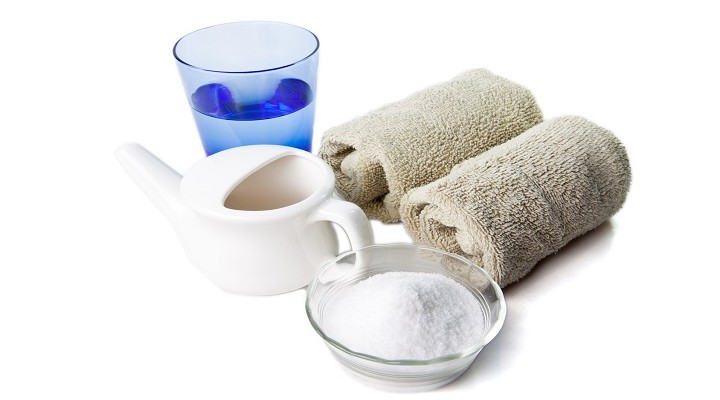
The nasal passages act like an air filter, catching microscopic debris before it gets deep down into the lungs. That debris includes all sorts of airborne substances like dust, mold, pollen, and microorganisms like viruses and bacteria. The nasal passages and sinuses cavities do have a fairly effective self-cleaning system, whereby debris gets trapped in mucus which dries out, clumps up, and eventually falls out… or gets picked out. It’s ok to admit it… we all do it.
Before we go on, a quick fun fact: When speaking with patients about their bodies, it often helps to use medical or scientific words to help decrease awkwardness that people sometimes feel. However, other than “dried nasal mucus,” there is no fancy medical term for “booger.”
So, other than nose picking, and using a tissue when we have allergies or a cold, most of us never think to clean our nasal passages — but we should. It’s a very simple thing to run a bit of salt water through your nasal passages, and I’d suggest that this should become a regular part of your routine, right along with brushing your teeth and washing your face.
In many countries, using a “neti pot” to irrigate the nasal passages with salt water is a routine part of daily hygiene. All over the world, neti pots sit on bathroom counters right next to the soap and toothbrushes. In my practice, I frequently recommend nasal irrigation for a number of different upper respiratory problems.
Nasal irrigation tends to work best for the following conditions:
1) Chronic rhinosinusitis: This condition involves inflammation in the nasal passages and the sinuses with mucous discharge that can drip through the nose or back down the throat. We also use the term “chronic nasal congestion” to refer to nasal stuffiness without significant mucous discharge.
2) Viral rhinitis: This is the medical term for a common cold and all the unpleasant symptoms that go along with it.
3) Allergic rhinosinusitis: This refers to inflammation in the upper respiratory tract that is triggered by allergic exposure to airborne particulates.
The salt water solution floods the nasal cavities with water, and flushes out the particles that have accumulated there. This safe and simple process can give people significant relief. I’ve seen it help congested people breathe easy for the first time in years.
A study testing the effectiveness of nasal irrigation on chronic and recurrent sinusitis was recently published in the journal CMAJ. In this study, researchers put nearly 900 people with chronic or recurrent sinusitis on a treatment plan consisting of either “usual care,” nasal irrigation, steam inhalation, or a combination of steam inhalation and nasal irrigation. Researchers followed up with the patients after three and six months to assess changes to their symptoms.
The data demonstrated that compared to other interventions, nasal irrigation led to improvement in sinus symptoms. It also led sinusitis patients to use less over-the-counter medications, and appeared to decrease doctor visits for sinus related symptoms. Clearly, this ancient practice, still relatively unknown in the Western world, can offer some noteworthy benefits.
Making your own saline nasal irrigation solution at home couldn’t be simpler. Start with a cup of lukewarm water (distilled is preferred), and add ¼ teaspoon of finely ground, non-iodized salt. Many people like to add a punch of baking soda, as well. That’s it.
The solution is typically made on the spot, right in the neti pot itself. You can find an inexpensive one at your local pharmacy. In fact, right next to the neti pots, you’ll also see boxes of pre-packaged salt solutions that make the saline preparation even easier. Once you have your neti pot full of saline, you’re ready to irrigate:
– Stand at the the sink and lean forward, holding the neti pot in one hand.
– Tilt your head to one side and tuck your chin toward your chest.
– Position the spout of the net pot into the nostril and allow the solution to flow up into the nasal passage.
– Keep your mouth open… and stay calm. You can breathe through your mouth even as the saline flows through your nose.
– Continue to pour the solution until you feel it draining from the opposite side.
– Blow your nose gently into the sink to flush out any remaining saline.
– Repeat on the opposite side.
Now, if this sounds horrifying to you, it’s because you probably hate the feeling of getting water up your nose. Many people have had bad experiences with that in pools, lakes, or the ocean as a child. But never fear… irrigating your nasal passages feels nothing like getting water up your nose. Getting water up your nose unexpectedly is very unpleasant. Nasal irrigation is not uncomfortable. You can breathe during the process, and it’s actually very refreshing. It also does a great job of cleaning infectious organisms, mucus, and allergens out of your nose. So, if you have a chronic nasal congestion, allergies, or a cold… get yourself a neti pot and give it a try!
– Dr. Joshua Levitt
No comments:
Post a Comment